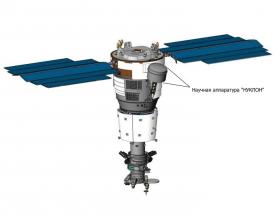On December 26, at 21:56 MLT a spacecraft “Resurs-P” N2 with scientific instrument “NUCLEON” was launched from Baykonur launching site to the orbit.
«Resurs-P» N2 is the second Russian satellite of the “Resurs-P” series. It is intended for high-resolution Earth imaging. The images with resolution up to 1 meter will be used for the mapping, environmental monitoring, appraisal of ice situation and many other tasks.
“NUCLEON” scientific equipment (from “nucleon” - nuclear particle) is developed and produced by SINP MSU scientists in cooperation with their colleagues from other Russian scientific organizations in order to study our Galaxy, its objects, to search for strange and dark matter by means of detection and analysis of the galactic cosmic rays – an intensive flux of hadron component: from the protons up to the heaviest nuclei, and less intensive flux of electrons and positrons.
Information on the basic characteristics of the galactic cosmic rays (particles distribution on their types and kinetic energy – energy spectra) and astronomical data in different ranges along with present-day ideas on the properties of fundamental particles will provide basis for the development of the model of our Galaxy in order to study its objects, for instance, neutron stars or supernovae. This model will also provide an opportunity for targeted search for the existence of antimatter, strange and dark matter.
Characteristics of the galactic cosmic rays can be determined accurately only beyond the Earth's atmosphere, because the Earth's surface can be reached not by primary cosmic rays, but only by secondary particles produced during the interactions in the atmosphere. Therefore the experiment “NUCLEON” is carried out beyond the atmosphere of our planet.
For space instruments there is a weight limit of about 300 kilograms. At the same time it is necessary to keep its sensitivity for high-energy particles. Usually such particles are detected with a very heavy instrument – ionisation calorimeter. Developers of the “NUCLEON” experiment, SINP MSU scientists succeeded in the solving of this problem by combination of a very thin ionisation calorimeter (microcalorimeter) and kinematic method. The method is based on detemination of the primary particle's energy by the mean spreading angle of the secondary particles cascade, produced by the primary particle in the dense matter. This method provides an opportunity to detect the particles with energy from 100 GeV up to 1 PeV.
The most part of other space-borne detectors of the galactic cosmic rays (AMS-02 onboard ISS, “Pamela” onboard the spacecraft “Resurs-DK1”) “observe” the particles with energy up to 1 TeV, the “NUCLEON” experiment will 1 thousand times expand this limit.
As the Principal Investigator of the project, the Head of the Laboratory of galactic cosmic rays of SINP MSU Dmitry Podorozhny said: «Inspite its small mass and size the “NUCLEON” instrument will double the global statistics collected during the past 50 years. And it is referred to the breakthrough data. For the first time we'll study wide energy range of cosmic rays as never before – by four orders – by mean of the single method during a long, not less than 5 years orbital experiment».

